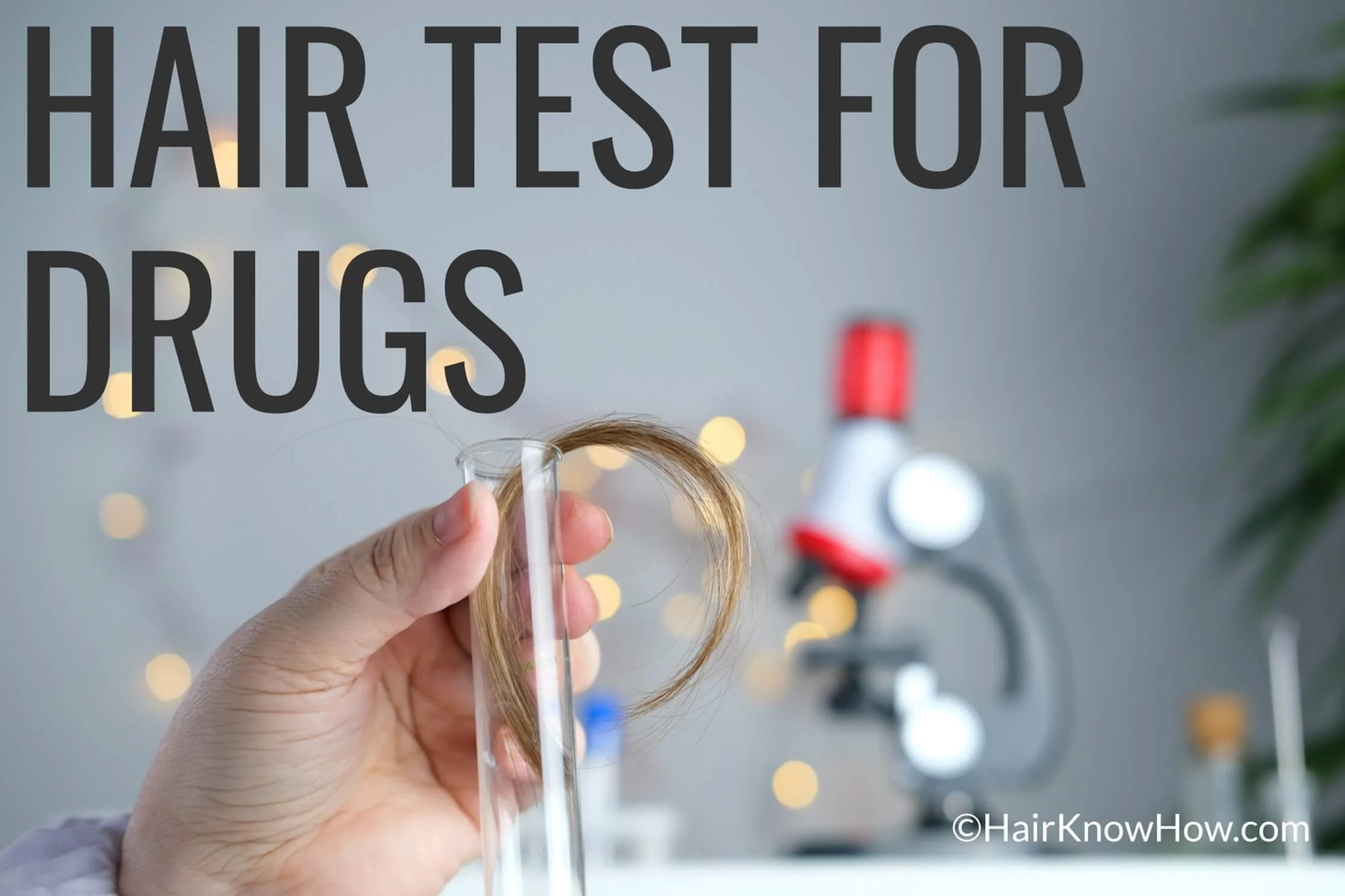Introduction To Hair Testing For Drugs - The Basics
Hair testing for drugs is a drug test that looks for the presence of drugs in a person’s hair. This drug test method is becoming increasingly popular because it is less invasive than other methods, such as urine or blood tests, and can detect the presence of drugs for up to 90 days after they have been used.
This article will discuss the ins and outs of hair testing for drugs, including how it works, detection times, accuracy, and ways to potentially pass a hair drug test.
There are several advantages to using hair testing for drug detection.
First, because hair grows at an average rate of 1cm per month, it can provide a history of drug use over that time.
Second, hair follicles are resistant to external contamination, so there is no need to worry about contaminated samples.
Finally, hair samples can be collected discreetly and without special equipment.
To collect a sample for hair drug testing, a small amount of hair (around 50-60 strands) is plucked from the back of the head near the crown.
The sample is then sent to a laboratory, where it is tested using an immunoassay type test. This process uses antibodies to identify the presence of drugs in the sample. If drugs are present, they will bind to the antibodies and be detected by the hair testing laboratory.
Hair testing for drugs is an accurate and reliable way to detect drug use. However, it is essential to remember that this type of test cannot determine how much or how often drugs have been used. Other types of hair tests are needed to find this information.
If you have questions about hair drug testing, please contact your healthcare provider or addiction specialist.
Hair Testing For Drugs - Sectors That Use Testing
Hair testing effectively detects drug use over a longer time than traditional urine drug tests. Employers, law enforcement agencies, and courts of law often use hair testing to determine if an individual has been using drugs.
What Is A Hair Test For Drugs?
A hair test for drugs is a screening process that analyses a sample of an individual’s hair for the presence of drugs and their metabolites. The hair sample is collected from the scalp, typically from the back of the head, but it can also be collected from other body parts. The sample is then sent to a hair testing laboratory for analysis.
Hair tests usually cost more than urine drug tests, but they are more accurate and can detect drugs used in the past few months.
Hair tests can detect the use of cocaine, marijuana, opiates, methamphetamine, and PCP.
Hair drug tests are generally more accurate than urine drug tests because they can detect drugs used in the past few months. Urine drug tests can only detect drugs used in the past few days.
Hair Testing For Drugs: Understanding The Process And Its Significance
Drug testing is common in many workplaces, sports organisations, and legal proceedings. The hair test is one of the most reliable and accurate drug testing methods. This method can detect drug use for up to 90 days, making it one of the longest detection windows among all drug testing methods.
The hair test is becoming increasingly popular because it is more accurate. Hair tests are also less likely to produce false positives. A false positive is when a person tests positive for a drug even though they have not used it. False positives can occur with urine and blood tests, but they are less likely to occur with a hair test.
Hair tests are also less invasive than urine or blood tests. These are just some of the advantages of hair tests.
The hair drug test is most commonly used to screen for cocaine, amphetamines, opiates, and marijuana. However, it can also screen for other drugs such as alcohol, phencyclidine (PCP), and MDMA.
How Do Drugs Get Into Hair For Detection By Hair Testing?
Hair tests work by analysing the drug molecules that are present in a person’s hair. When drugs are consumed, they enter the bloodstream, and small amounts of the drug molecules can be deposited in the hair follicles. The drug molecules become trapped in the hair shaft as the hair grows. This means that a hair test can detect drug use over a longer time than traditional urine drug tests, which can only detect drug use within the past few days.
The Procedure For Drug Testing Using A Hair Test
A hair sample is collected by cutting a small sample as close to the scalp as possible.
After that, a hair testing laboratory receives the hair sample for analysis.
The laboratory examines the hair sample using a process known as a “hair strand test.”
The hair is first washed to prevent external contaminants from contaminating the test results. After being washed, the hair is cut into small pieces and put through a series of chemical tests to see if any drugs or their metabolites are present. To perform this hair test, the hair must be submerged in a solution that dissolves the hair’s outer layer, leaving only the inner core.
The hair testing lab can identify the drug and metabolite molecules in the hair’s inner core (the cortex) using various techniques, including gas chromatography/mass spectrometry (GC/MS).
Cocaine, marijuana, amphetamines, opiates, and PCP are the drugs that are most frequently detected in hair tests.
Immunoassays comprise most of the drug tests performed on hair samples by hair testing labs. Antibodies are used in this type of hair testing to detect the presence of particular drugs or their metabolites.
Immunoassay tests are typically quick and straightforward to perform, but they occasionally yield false-positive results. This is why more accurate and sensitive techniques, like gas chromatography/mass spectrometry (GC/MS), are frequently used for confirmatory hair testing on positive samples. These are just some of the types of hair test types available.
What Drugs Can Be Detected With A Hair Test?
Hair drug tests can detect a variety of drugs, including marijuana, phencyclidine (PCP), cocaine, opiates, methamphetamine, and more. The detection window for hair drug tests is much longer than urine or blood tests, making them an excellent option for employers who want to screen for recent drug use.
Hair testing can also detect alcohol, although this is less common as the detection window for alcohol testing is shorter than for other drugs.
Accuracy Of Hair Tests For Drugs
With a 99% reported accuracy rate, hair tests are regarded as being very accurate. This is because drugs and their metabolites last longer in hair due to increase half-lives than in other bodily fluids like urine or blood.
Hair tests are thus better able to detect recent to mid-term drug use. The procedure for testing and analysing hair is rigorous, and results are typically double-checked using at least two different hair testing methods.
Hair testing is the perfect tool for employers who want to check job applicants for drug use.
Several variables can impact the accuracy of a hair test. For instance, if the hair sample is contaminated, dyed or treated with alcohol-containing haircare products. However, a hair test might not be able to find drugs if the person uses them infrequently.
What Are The Advantages Of Using Hair Tests For drugs?
Longer Detection Window: The primary advantage of a hair test is its long detection window of up to 90 days. This makes hair testing much more effective in detecting long-term drug use than urine or blood tests, which only detect drugs for a few days after use.
Hair tests are not affected by diuretics or other substances that can interfere with other drug tests.
Non-invasive: Hair tests are non-invasive, and the sample collection process is relatively simple and painless and can even be performed without needing a bathroom.
Less chance of cheating: Hair tests are difficult to cheat, as the sample cannot be altered or substituted like in urine tests.
Testing multiple drugs: Hair tests can detect a wide range of drugs, making it a highly efficient method of detecting multiple drug use.
Finally, hair tests are more expensive than urine or saliva drug tests, but they are still relatively affordable.
What Are The Limitations Of Hair Tests For Drugs?
Hair tests are not perfect, and there are some disadvantages to hair tests.
Expensive: Hair tests cost more than urine or blood tests.
Mostly limited to the hair on the head: Hair tests primarily detect drugs within scalp hair. This is because hair from other parts of the body, such as facial hair or body hair, is simply not long enough and taking these samples creates additional privacy concerns.
Drugs may not be detected immediately (within the past few days) after use, as they need time to be incorporated into the hair fibres and at sufficient concentration to be detected.
Finally, hair testing is not typically used to test for alcohol use, though hair testing for alcohol is increasing.
Who Uses Hair Tests For Drugs?
Hair tests for drugs are commonly used in workplaces, sports organisations, and legal proceedings. Many companies use hair tests as part of their pre-employment screening process, random drug testing of employees, or to test employees who may be suspected of drug use.
Sports organisations use hair tests to detect doping among athletes.
In addition, in legal proceedings, hair tests may be ordered by courts to determine if a parent has a history of drug use as part of child custody or divorce proceedings or by probation officers as part of a criminal sentence.
Tips For Passing A Drug Hair Test
While it is never recommended to use drugs, if you are in a situation where you must pass a hair test, a few methods may help. There is no guaranteed way to pass a hair test, but several things can be done to increase the chances of passing.
Time: The most effective method is simply waiting for the drugs to clear from your body. The detection window for a hair test is up to 90 days (for a short hair sample of around 1.5cm), so it may take some time for the drugs to be undetectable.
Avoid exposure to secondhand smoke. Stand away from friends smoking drugs inside a building or go outside with them.
Hair Detox: Use a clarifying or detox shampoo several times in the week leading up to the hair test. Hair detox products available on the market claim to remove drugs from the hair. However, the effectiveness of these products is questionable, and they may not altogether remove all traces of drugs from the hair.
Shaving your head: Another option is to shave your head. However, this may raise suspicion and is not always a feasible option.
It is important to note that cheating on a drug test is illegal and unethical.
Remember that drug abuse can seriously negatively affect your health and personal life.
Can You Use Shampoo to Pass a Hair Test?
Several products on the market claim to help individuals pass a hair drug test, such as shampoos and detoxifying agents. However, it is important to note that these products have not been scientifically proven effective in passing a hair test.
Using these products can potentially damage the hair sample and make the test results inaccurate. So, if you are required to take and pass a hair test, it is best to refrain from using any type of cleansing product on your hair beforehand.
Detection Time for Different Drugs In A Hair Test
The detection time for drugs with a hair test varies depending on the drug. For example, marijuana can be detected in a hair drug test for up to 90 days after use, while cocaine can be detected as early as 3-5 days.
Amphetamines, cocaine, opiates, and PCP can be detected for up to 90 days (depending on hair length). Cannabis can be seen for up to 60 days. Benzodiazepines can be detected for up to 30 days. Barbiturates can be detected for up to 14 days. Alcohol can be detected for extended periods. These are not exact and will vary from person to person.
It is important to consult with a professional to determine the detection time for a specific drug.
Most employers require a hair test as part of their pre-employment screening process. Hair tests are more effective at detecting long-term drug use than urine or blood tests. Hair tests can detect drug use up to 90 days previous, whereas urine tests can only detect drug use within the prior few days. Blood tests are even less effective, as they can only detect drug use that occurred within the past 24 hours.
Interpreting Hair Test Results
A report containing the drug detection levels in the hair sample usually is provided as part of a hair test.
Positive hair test results are considered to be above a certain threshold level, while negative hair test results are considered to be below that level.
A hair sample test can be very reliable in determining whether someone has used drugs within the previous 90 days.
Typically, the results of a hair test are presented as a numerical value representing the amount of drug metabolites present in the sample. The reported figure is contrasted with a cut-off value unique to each drug and type of hair test.
A positive result is obtained if the sample’s drug metabolite concentration exceeds the cut-off value.
Several variables can affect the interpretation of hair test results.
First, it’s important to know that hair typically grows at around 1 cm per month.
This means that a typical hair sample can be used to detect drug use up to 90 days before the test date.
Second, different drugs and medications have varying half-lives in the body and are metabolised in various ways.
This means that some drugs are more easily detected and in different quantities than others in hair testing.
Last but not least, different laboratories will use other techniques or variations of methods for analysing hair samples, which may result in slightly different results.
However, hair testing is regarded as a precise method to identify recent drug use.
If you have any questions about your results, it is important to talk to a qualified medical professional who can help you interpret them correctly.
Comparing Hair Tests To Urine Drug Tests
Hair tests and urine drug tests are both commonly used to detect drug use, but they have some key differences.
A hair test is a more accurate measure of drug use than a urine drug test. Urine drug tests can detect drug use over a shorter period, usually up to a few days, while hair tests can detect drug use over a longer time, usually up to 90 days or longer. Urine drug tests are more susceptible to being tampered with, while hair tests are more tamper-proof. Hair drug tests are also less likely to be affected by factors such as dehydration, which can impact the results of a urine drug test.
However, urine drug tests generally cost less and are easier to administer than some other types of drug tests.
Drug Detection Cut-Off Limits In Hair Tests
Drug detection limits in hair drug tests vary depending on the type of drug being tested for.
For example, the detection limit for:
Marijuana: 1pg/mg of hair.
Cocaine: 0.5 ng/mg in both screening and confirmation tests.
Cocaine metabolites (benzoylecgonine; norcocaine): 50 pg/mg.
Carboxy-tetrahydrocannabinol (THC) metabolite: 0.3 ng/mg.
MDMA: 0.15ng/mg.
Heroin: 0.05ng/mg.
Morphine, codeine, and heroin metabolite 6-monoacetylmorphine: 300 pg/mg for
Opioids: 300pg/mg
Methamphetamine: 500pg/mg
Phencyclidine (PCP): 0.02ng/mg
These limits can vary depending on the laboratory conducting the test, so it is essential to consult with a professional from the specific hair testing lab whose service you are using.
How Does A Hair Follicle Drug Test Work?
A hair follicle drug test works by taking a small sample of hair from the head and sending it to a hair testing lab for analysis that will analyse the hair sample for the presence of drugs and their metabolites.
When a person ingests drugs, the chemicals in the drugs enter the bloodstream and are then incorporated into the hair via the hair follicles. The drugs and their metabolites remain in the hair shaft for an extended time, usually up to three months.
Hair testing can detect drug use over a longer time than traditional urine drug tests, which detect drugs used more recently (1-2 weeks). Hair tests can detect drug use even if someone has only used drugs once or twice.
Summary - Hair Drug Testing
Hair testing has proven to be an effective and reliable method of detecting the presence of numerous drugs within a person’s body. The non-invasive nature, accuracy, long detection window, and relatively low cost make hair testing appealing for employers and other agencies who may wish to screen individuals or groups for the presence of drugs.
If you’re an employer or organisation looking to implement hair testing, consulting with legal and HR experts is vital to ensure compliance with relevant laws and regulations.
With that said, it is important to consider any potential ethical or privacy issues associated with hair testing before using this screening process.
Get Expert Hair Analysis and Help
If you are interested in learning about hair testing or have a hair concern you would like to discuss, then please do get in touch. Contact the HairKnowHow Team if you have any questions.











